by Peter Barton
Administrator, Nevada Division of Museums and History
A little past Noon on Monday, May 9, 1910, a futuristic rail car rolled down the tracks along Washington Street in Carson City and eased up to the Virginia and Truckee Railway depot.
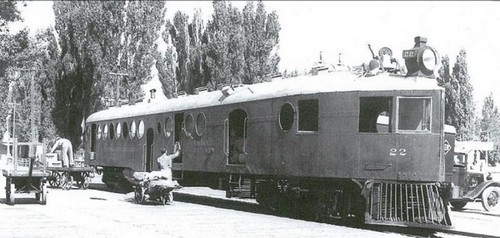
Deep rich red in color, over 70 feet in length, all-steel, with round porthole windows with a “nautical” look, an innovative “wind-splitter” pointed prow, and self-propelled, it drew a crowd of curious on-lookers. What was this alien vehicle? It was a McKeen Motor Car: car #70 of the McKeen Motor Car Works of Omaha, Nebraska. It was delivered to the renowned Virginia & Truckee Railway (V&T) in May, 1910, where it operated for 35 years in service to rural northern Nevada.
The Carson City News wrote this in the May 10, 1910 edition: “Yesterday afternoon the gasoline motor car of the V&T railroad arrived from Omaha under the care of E. C. Peterson, the machinist sent from this city a few weeks ago to get it. The car came from Omaha on its own power and was run as a special train. It is one of the finest cars in the west and will prove to be of great benefit to the traveling public. It is of eighty-five passenger capacity, has
engines of 200 horse power and great speed. It is a large roomy car, neatly upholstered, well lighted and ventilated and with the name of being a very easy rider…
“The car is eighty feet in length, with two compartments, one to be used as a smoking room. The outside the car is painted a very rich wine color with gold lettering. It is numbered 22…
“Mr. Peterson left Omaha with an assistant on Monday the 2nd of this month. They traveled day and night and considering that the distance is nearly fifteen hundred miles, they made good time.”
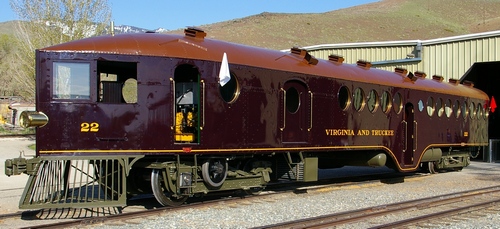
The Virginia & Truckee Railroad had been reorganized in 1904 as the Virginia & Truckee Railway, as the result of declining revenues after the Comstock mining boom ended. As it was extending its rails south to Minden to serve the agricultural needs and business developing in the Carson Valley, the V&T sought a less expensive option for passenger, mail and express service on its 70-mile line in northern Nevada. Steam powered trains typically required multiple cars and much larger operating crews.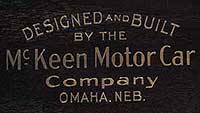 The McKeen Motor Car offered an appealing alternative, and the railway ordered a McKeen car in the fall of 1909 for delivery in the spring of 1910. The cost was $22,000 f.o.b. Omaha, Nebraska. The railroad numbered the car No. 22.
The McKeen Motor Car offered an appealing alternative, and the railway ordered a McKeen car in the fall of 1909 for delivery in the spring of 1910. The cost was $22,000 f.o.b. Omaha, Nebraska. The railroad numbered the car No. 22.
The local newspaper later took to referring to the McKeen Motor car as the “red dragon” presumably on account of its odd appearance and deep red color. The car went into service in June 1910, about a month after delivery. With its light weight (34 tons) and top speed of just over 30mph, it was ideally suited for the lightly maintained V&T. That is, except for the line to Virginia City, which was characterized by tight curves and a ruling grade that exceeded 2% — too steep and curly for the McKeen Car to navigate. Only one trip of the McKeen motor car to Virginia City is documented.
The car was modified in the 1910s and 1920s, taking advantage of advances in electric lighting and adding an air horn. With a further decline in demand for passenger service, the V&T withdrew the car from service in October 1929, and then sought to rebuild the car — adding a Railway Post Office (RPO) section in order take advantage of stable post office revenue.  Approval to add the RPO was granted by the U. S. Post Office Department in 1932, and the rebuild was completed and the car returned to service in October of that year, on a three-day-a-week schedule between Reno, Carson City and Minden. The car stayed in service until October 31, 1945, when it was retired by the V&T, as demand for service had further declined and the railroad had increased difficulty maintaining the car. In thirty-five years of service the car had accumulated nearly 500,000 miles on the railroad.
Approval to add the RPO was granted by the U. S. Post Office Department in 1932, and the rebuild was completed and the car returned to service in October of that year, on a three-day-a-week schedule between Reno, Carson City and Minden. The car stayed in service until October 31, 1945, when it was retired by the V&T, as demand for service had further declined and the railroad had increased difficulty maintaining the car. In thirty-five years of service the car had accumulated nearly 500,000 miles on the railroad.
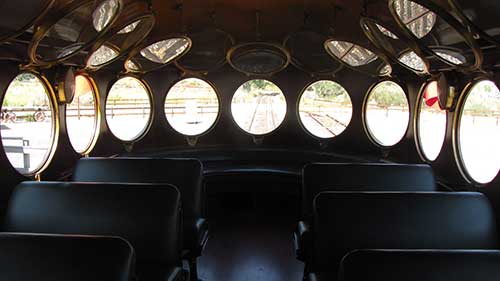
The layout of the McKeen car was as follows: at the front of the car was the engine room, where a 200 horsepower open-frame distillate (gasoline) engine provided power to 42” drive wheels via a chain drive connected to a two-speed transmission. Top speed was listed as 32.5mph. The engineman sat on the right side of the cab where he operated the controls, brakes, bell, and whistle. To the rear of the engine room was the baggage room, which featured large sliding doors and a conductor’s desk. To the rear of the baggage room was the smoking compartment, with a seating capacity of 30. A men’s toilet was located adjacent to the doorway and vestibule for passenger loading. To the rear of the vestibule was the non-smoking section, with seating for fifty persons, with an additional toilet adjacent to the vestibule. The rounded rear tail of the car featured a wrap-around bench seat with capacity for up to ten passengers. The large and distinctive porthole windows were 24 ¾” in diameter, operable and constructed of brass-finished aluminum. The interior of the car consisted of a variety of materials, including maple floors and mahogany wainscoting. Seats were upholstered in dark green imitation leather. All interior lighting, as well as the headlamp, was fueled by acetylene gas. McKeen insisted on building all component parts for the cars in-house, versus turning to outside vendors.
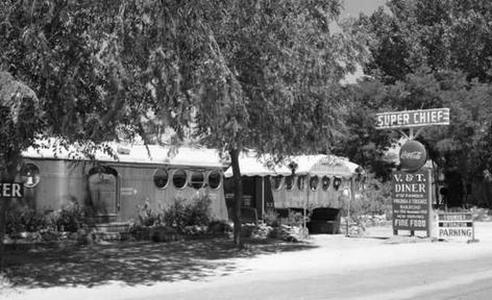
Soon after being removed from service in 1945, the V&T scrapped the engine and the trucks from the McKeen car. In August 1946, the railroad sold the car body to Carson City restaurant owners for $1,000. The car subsequently became a restaurant and, later, an office and storage facility. In 1995 it was donated to the Nevada State Railroad Museum, where a 15-year restoration effort resulted in what you see here, the last remaining McKeen Motor Car still operating. It’s an extremely rare example of the first commercially viable self-propelled railway motorcar powered by an internal combustion engine. It represents the application of streamlined aerodynamic design, use of all-steel in the frame and body structure, use of lightweight aluminum, and incorporates trend-setting design elements of the day (i.e. nautical elements, clean exterior lines and curves). With a crew of two (engineman and conductor), the railroad was able to reduce operating costs of a typical steam locomotive powered train, which required a crew of five or more.

The car was relocated from the V&T shops to 1111 N. Carson Street and opened as “Denny’s Diner” (sans railroad furnishings) in late 1946.It was later moved to 1604 N. Carson Street in 1948, and to 1400 S. Carson Street in 1955. During this time it operated under different names, including the “V&T Diner” and the “Super Chief.” By the early 1960s the diner had closed, and the car body was acquired by the owners of Al’s Plumbing and Heating, subsequently being used at various times for offices and storage. In 1995, the Bernhard family, recognizing the unique nature of the resource (and a 1913 Hall-Scott gas rail motor car they’d acquired from the Nevada Copper Belt Railroad), donated the car to the Nevada State Railroad Museum. The gift came with the restriction that the museum undertake and complete a restoration to operating condition.
The McKeen Motor car is in the collection of the Nevada State Railroad Museum in Carson City. The Museum operates on a 13-acre campus located at 2180 S. Carson Street and consists of several buildings, both new and relocated historic structures. A loop of standard-gauge track, along with lead and a “wye” for turning, a 60 foot turntable and display tracks comprise the operating railroad. The museum’s location is adjacent to the lumber yards of the former Virginia & Truckee Railroad and is within sight of the original V&T Minden Branch, over which the McKeen Motor Car regularly operated.



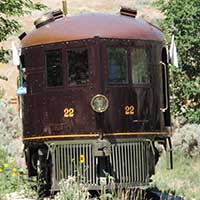
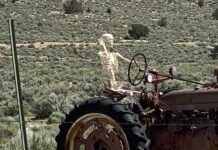

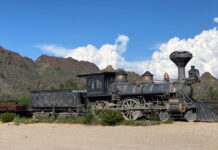
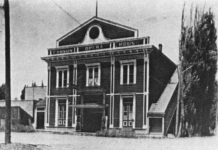
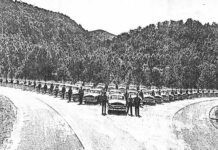







The McKeen was so slow…how slow was she?
She transported a prisoner from Minden to Carson,
and by the time she got him there he had aged so,
they could no longer identify him, and had to let him go…
What was cost of riding the McKeen railroad car from Carson City to Minden when first put in use?
Sorry for the delay in answering, most of this is from Stephen Drew, the rest from Wendell Huffman:
One way Carson to Minden in the teens was $1.00. New Passenger Tariff No. 9 effective February 1, 1921 lowered it to 85-cents. Half fares were allowed for children and Indians. Special Sunday Round Trip fare Carson-Minden and return was 90 cents.
There was not a different fare for the McKeen or regular train—the motorcar was considered a train.